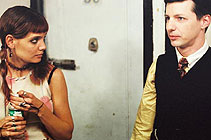|
|
|
|
Pieces
of April
|
 |
|
The scriptwriting gurus who tour Australia usually offer a simple, banal piece of advice: you need an involving story with intriguing characters. Fair enough. But such an attitude has led to a monstrous trend: a growing army of independent filmmakers, armed with new, lightweight, digital cameras, who believe that all they need to do is throw some good actors together in a hothouse situation and watch them emote. In the process, everything else that goes to make up a movie – like a sense of aesthetic style, or a patterned structure of incidents and motifs – goes out the window. And as those digital cameras can just keep churning on for hours, and the improvising actors are enjoying themselves, we get shapeless riffs on basic situations of human interaction. The company InDigEnt (Independent Digital Entertainment) specialises in such sorry fare. For young American filmmakers, Thanksgiving dinner is among the favourite pretexts for a movie of this kind. The members of a grandly dysfunctional family gather; there are reunions, arguments, reconciliations. There will usually be a black sheep, someone with a hidden life, a surly parent who needs to open up, and a medical crisis on the horizon. The one novel aspect of the dreary, by-the-numbers Pieces of April is that the car journey of most of the Burns family to the New York apartment of their wayward daughter April (Katie Holmes) takes much longer than the actual Thanksgiving dinner. In fact – mercifully – that dinner scene is really no more than a few static snapshots. And, at last, writer-director Peter Hedges enjoys the expressive potential of a wordless, economically staged moment. The rest of the movie is painful. Hedges saddles himself with a repetitive, alternating structure – the family's ride intercut with April's frantic, novice attempts at cooking – that stays in one, low-energy gear. The problem is not helped by the fact that April's likeable boyfriend, Bobby (Derek Luke), spends most of the movie idly bumming around the streets, or that most of her neighbours are tiresome eccentrics. The project is filled with fine actors, such as Patricia Clarkson as the ailing mother reluctantly along for the ride, but most (as in a bad Mike Leigh movie) are constrained to project the same tics (like annoyance or dottiness) over and over. Oliver Platt, however, makes a good impression by underplaying his usual, comic schtick. This is the ugliest-looking digital movie since a previous InDigEnt production, Tadpole (2002). The skin tones are awful, light washes out the backgrounds, there is little depth or definition in the image. Like many independent films of its ilk, it creates its few good moments despite, not because of, its new-fangled and oppressive technology. © Adrian Martin March 2004 |
![]()